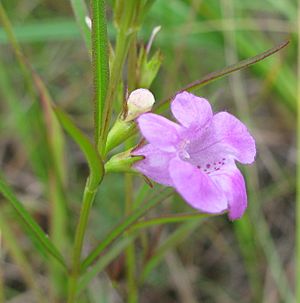Smallflower false foxglove facts for kids
Quick facts for kids Smallflower false foxglove |
|
|---|---|
 |
|
| Purple bloom | |
| Scientific classification | |
| Genus: |
Agalinis
|
| Species: |
paupercula
|
| Synonyms | |
The smallflower false foxglove, also known as Agalinis paupercula, is a special kind of plant found in eastern parts of the United States and Canada. It's an annual plant, which means it lives for only one growing season. This plant is also a hemiparasite, meaning it gets some of its food from other plants.
You can find the smallflower false foxglove growing in open, damp places. It has pretty purple flowers that grow on a stem about 30 to 70 centimeters (12 to 28 inches) tall. These flowers usually bloom in August and September. Scientists have sometimes thought this plant might just be a type of Agalinis purpurea, which is the purple false foxglove. Early genetic tests suggest they might even be the same species!
Contents
What Does the Smallflower False Foxglove Look Like?
This plant is an herbaceous annual, meaning it has soft stems and lives for one year. It grows straight up, reaching about 30 to 70 centimeters (12 to 28 inches) tall. Its stem is smooth and has four sides. It might grow as a single stem or have many branches.
The stems have leaves that grow directly opposite each other. These leaves are long and thin, about 2 to 4 millimeters (0.08 to 0.16 inches) wide. They don't have any lobes or extra parts. Leaves on the branches might grow in an alternating pattern.
The Beautiful Flowers of Agalinis paupercula
The flowers of the smallflower false foxglove appear from August to September. They grow in clusters called racemes. Each flower sits on a small stalk, or pedicel, which is about 1 to 4 millimeters (0.04 to 0.16 inches) long. These stalks grow from the spots where the upper leaves meet the stem.
Each flower has a green outer layer called a calyx. This calyx is made of five sepals that are joined together at the bottom, forming a tube. The top parts of the sepals are separate and pointed. Inside the calyx is the colorful part of the flower, called the corolla. It's shaped like a bell and is pink to purple. The corolla has five slightly uneven, spreading lobes.
The corolla is about 1.5 to 2 centimeters (0.6 to 0.8 inches) long. It often bulges a bit on its underside. Inside the flower, there are four stamens, which produce pollen, and a flat stigma, which receives pollen. The lower two stamens are longer than the upper two. The parts of the stamens that hold the pollen (called filaments) are a bit hairy near their base. After the flowers bloom, they turn into round fruits.
How to Tell Agalinis paupercula Apart from Similar Plants
The smallflower false foxglove looks very much like Agalinis purpurea, the purple false foxglove. Some scientists even think they might be the same plant! But you can usually tell them apart by looking at their flowers. A. paupercula has smaller flowers, with its corolla being 1.5 to 2 cm long. A. purpurea has larger flowers, with a corolla of 2 to 4 cm. Also, the pointed parts of the calyx on A. paupercula are almost as long as the calyx tube, while on A. purpurea, they are usually much shorter.
The Scientific Name and History of Agalinis paupercula
This plant was first described by a scientist named Asa Gray in 1878. He called it Gerardia purpurea var. paupercula. He noticed it had smaller flowers, a taller stem, and a lighter color compared to other Gerardia purpurea plants.
Later, in 1894, another scientist, Nathaniel Lord Britton, decided it was different enough to be its own species, so he named it G. paupercula. In 1913, he moved it and other similar North American plants into a new group called Agalinis, giving it the name A. paupercula.
Today, some genetic studies have not been able to find clear differences between A. paupercula and A. purpurea. This means it's possible they might be grouped together again as one species in the future. However, these studies didn't look at many A. paupercula plants, so more research is needed to be sure.
Where Does the Smallflower False Foxglove Live?
The smallflower false foxglove grows in the northeastern United States and eastern Canada. Sadly, it's considered a threatened plant in New York state. It's even more serious in Pennsylvania and Ohio, where it's listed as an endangered plant. In New York, it's only found in one specific spot: Ronkonkoma Lake on Long Island.
This plant loves sunny, moist places. You can often find it in wet areas like bogs, along shores, in open barren lands, and in sandy soil.
How Agalinis paupercula Interacts with Its Environment
As we mentioned, Agalinis paupercula is a hemiparasite. This means it gets some of its food and nutrients by connecting its roots to the roots of other plants, both woody trees/shrubs and other soft-stemmed plants. It doesn't completely rely on them, but it does "borrow" some resources.
When it comes to making new plants, A. paupercula is self-compatible. This means a single plant can produce seeds on its own without needing pollen from another plant.

